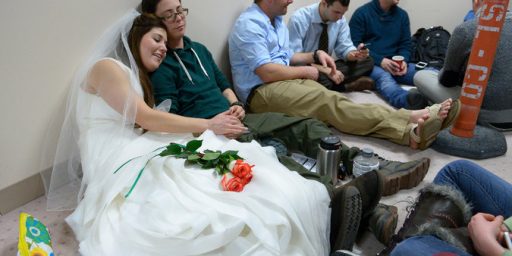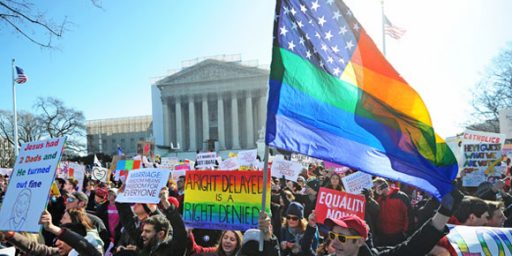Supreme Court Denies Effort To Block Same-Sex Marriages In Oregon
Last month, a Federal District Court Judge in Oregon struck down that state’s ban on same-sex marriage and, in response, state officials from the Governor on down announced that they would not appeal the decision, thus making the Judge’s decision final and same-sex marriage legal. In response,the National Organization For Marriage, which had previously failed in its efforts to intervene in the case at the District Court level, petitioned higher courts to block the District Court ruling pending an appeal that, presumably, they would have prosecuted themselves. Yesterday, the Supreme Court blocked those efforts:
WASHINGTON — The Supreme Court on Wednesday rejected a request to halt same-sex marriages in Oregon. The court’s one-line order gave no reasons for declining to issue a stay.
Many gay and lesbian couples have gotten married in Oregon since a May 19 decision from Judge Michael J. McShane of Federal District Court in Eugene, Ore., struck down the state’s ban on such marriages.
“With marriages continuing in Oregon, we have 44 percent of the country living in a freedom-to-marry state,” said James Esseks, a lawyer at the American Civil Liberties Union, which represented some of the plaintiffs in the Oregon case. Same-sex marriages are permitted in 19 states and the District of Columbia.
State officials had declined to appeal Judge McShane’s decision. Oregon’s attorney general, Ellen F. Rosenblum, told the Supreme Court that there was “no rational basis on which to defend the state’s same-sex marriage ban.”
The request to the Supreme Court that the decision be stayed came instead from the National Organization for Marriage, which opposes same-sex marriage.
The organization’s brief reminded the justices that they had issued a stay in January of a federal trial judge’s ruling allowing same-sex marriages in Utah. But that request had come from state officials.
In declining to grant its request for a stay, the justices may have harbored doubt about whether the group had suffered the sort of direct injury that would give it standing in the case, National Organization for Marriage v. Geiger.
Last June, in Hollingsworth v. Perry, the Supreme Court ruled that proponents of Proposition 8, a voter initiative that had banned same-sex marriage in California, did not have standing to appeal a ruling striking it down.
Lyle Denniston comments:
Although the Justices did not explain their order, the clear implication of it was that the Court would not be likely to postpone lower court rulings against same-sex marriage bans unless they were asked to do so by state officials. Last June, in Hollingsworth v. Perry, the Court refused to allow the sponsors of a state ban in California (“Proposition 8″) to pursue an appeal in place of state officials, who had declined to do so. After that, same-sex marriages were legal and were performed in the nation’s largest state.
County officials in Oregon have been issuing marriage licenses in the wake of the judge’s decision nullifying the ban. The same has been true in Pennsylvania, where state officials also declined to appeal a ruling against their state’s ban, and no one else has come forward to try to pursue an appeal or a delay.
Counting Oregon and Pennsylvania, there are now nineteen states in which same-sex marriages are permitted. In eleven other states, judges have issued orders striking down bans on such marriages, or narrower bans on recognition of such marriages performed out of state. Those rulings, though, are on hold while appeals proceed.
In the nearly full year since the Supreme Court, in United States v. Windsor, ruled unconstitutional a key part of the federal Defense of Marriage Act, no federal or state court has upheld a ban on same-sex marriages. Many of the decisions rely on reasoning in theWindsor ruling, even though the Court stressed there that it was not ruling on a state’s authority to ban such marriages.
Same-sex marriage cases are now unfolding in five federal courts of appeals. The cases are furthest along in the U.S. Court of Appeals for the Fourth Circuit, which sits in Richmond, Virginia, and the U.S. Court of Appeals for the Tenth Circuit in Denver, where briefing and hearings have concluded. The other cases are awaiting briefing or hearings in the Fifth, Sixth and Ninth Circuits.
Given the ruling in Hollingsworth, this was likely a no-brainer. In that case, of course, the Court had ruled that outside groups lacked standing to pursue an appeal of a District Court decision striking down California’s Proposition 8. This was precisely the same situation. NOM has no standing to defend the state law if the state doesn’t choose to pursue an appeal. Therefore, it’s request for a stay to block marriages in the state had no merit.






“National Organization for Marriage” wins the Newspeak award for 2014. As a semantic misdirection, it’s about the equivalent of the Sierra Club renaming themselves “National Organization for Forestry”.
He or she still looks like he’s 25. Amazing.